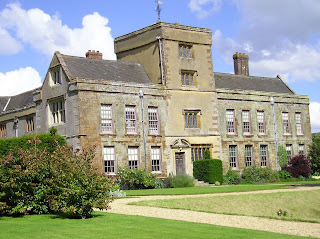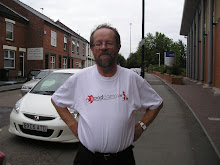We’d been intending to go to Stowe Gardens, but with Silverstone Grand Prix on, traffic is a little dense around some areas close by. So we had one of those days when you just stop where you feel like it and breath the fresh air. It’s been the best day we’ve had since we’ve been in England, in terms of sunshine. Not a drop of rain.
Our first diversion was Blisworth, which is just up the road from Roade. It turned out to be a lovely village and it had a canal running through it. In fact, Blisworth used to be a centre for storage in the 19th century, and a huge warehouse still stands by the side of the canal. We walked along the canal for some distance until we met a friendly dog on one of the canal boats. She turned out to be only 12 weeks old, and is an otter hound, a fairly rare dog these days. Her (lady) owner came out to see who she was talking to and we got chatting about living on a canal boat. And then her husband came along (he’d been making a cellphone call further along the path) and we found out that red diesel is what they use on the boats, but that soon, because of the European Union, they’re going to have to use black diesel. However, the French will still be allowed to use the cheaper red diesel!
We found out it costs £10 a night to moor in some parts of the canals, but in other places you can moor for a fortnight for free. To register your boat costs £500 a year, and that’s going up. The boat owners we were talking to have installed solar panels for some assistance with their electricity, but they also have a log burner on board, and in the winter (`even when it’s snowing’) they have to have the windows open because it’s so hot.
Finally Celia asked the ultimate question: could we have a look on board? The woman apologised for the mess the dog had made but in fact the interior was relatively tidy. Just inside the open deck area was the lounge, with a sofa and tv - the boat has all mod cons - and then there was the kitchen, then the bedroom with a double bed alongside one wall, and then the bathroom area with toilet, shower, bath - everything. And then further along still was the engine room and so on. It all seems so compact.
The husband had taken early retirement because he was so stressed working as a lorry driver. Now they just wander and stop where they like. It’s the sort of lifestyle that has an appeal, yet I don’t know that it would be for us, for more than a short period.
After this we walked to the next bridge, where there was a water run-off, and then back along the road to the car. Decided to go to Leitchborough as our next stop, and have lunch. Sat on the seat at the side of the road and watched three bikies go past, come back driving in the opposite direction, and then come back for a third time. Thought I should offer them our GPS.
Earlier in the week we’d thought about going to Canons Ashby (which for some reason I’ve been called Canons Albery for the last few days), as it’s a National Trust house. At first we were concerned about the Silverstone traffic, but there was none at that stage of the day.
CA was a bit disappointing, probably because we immediately compared it to Blickling. But CA is a NT house in decline, and there’s still a lot of restoration to do, and some that can’t be done. It’s very much tied into the history of the Dryden family (John Dryden, the writer, was a cousin
 of one owner), and the church across the road, where the Augustinian Canons once had not only a church building twice the size of what remains, but cloisters, farms and various other buildings, has the Dryden family names all over it. The buildings are nearly all gone, except for the smallish church with a seemingly much larger outside (rather like an inverse Dr Who tardis). It’s one of only four private churches in the UK. The Drydens are buried inside and outside, their banners are on the walls, and their lozenges, which are a kind of coat of arms on a diamond shape.
of one owner), and the church across the road, where the Augustinian Canons once had not only a church building twice the size of what remains, but cloisters, farms and various other buildings, has the Dryden family names all over it. The buildings are nearly all gone, except for the smallish church with a seemingly much larger outside (rather like an inverse Dr Who tardis). It’s one of only four private churches in the UK. The Drydens are buried inside and outside, their banners are on the walls, and their lozenges, which are a kind of coat of arms on a diamond shape.The house became more interesting as you moved through it. It’s been badly altered on a number of occasions: doors have been shifted, windows closed up and covered with a tapestry (and a door-sized shape cut into another tapestry); a fireplace that has plaster work on it is all skew-whiff because of the weight of the ceiling above it (the ceiling has been kept in place by the NT with a steel girder); two staircases go up side by side at one point, and in one room the original floor has been lowered by at least a foot. This, I think, was only discovered by the NT recently, and they’ve removed some of the later wall to expose the original house that’s
 underneath, with old paintings done directly on the wall now visible as well as the place where the original floor sat. In the gallery there are a number of portraits and watercolours; most of them are hard to see because there’s so little light from the tiny Elizabethan windows. The doors opposite the windows are at all angles, because the house doesn’t sit straight - but behind these doors, apparently, are offices and bedrooms belonging to the owners of the house, who come home every so often.
underneath, with old paintings done directly on the wall now visible as well as the place where the original floor sat. In the gallery there are a number of portraits and watercolours; most of them are hard to see because there’s so little light from the tiny Elizabethan windows. The doors opposite the windows are at all angles, because the house doesn’t sit straight - but behind these doors, apparently, are offices and bedrooms belonging to the owners of the house, who come home every so often.It’s a strange place, but homely, somehow. The gardens are lovely, with a massive tree that has pinecones sitting on top of the flattish branches in groups of twenty or more, and various shrubs that have been trimmed into unusual shapes.
After we’d done the house, gardens and church, we headed back and stopped off in Greens Norton, another pleasant village. We went for a walk, which turned into a bit of a marathon, because we were following a path that led to something called the Pocket Park. One woman we met claimed it was lovely, so we persevered. After what seemed like half an hour of walking, we came across an area that used to be clay pits. It’s now been allowed to go back to nature, and this is the famed Pocket Park. A lake has been formed - it’s not very large, rather more of a oversized pond - and it’s covered in perfectly normal water scum. That’s fine for the wildlife, but not overexciting to look at. However, we were too tired to walk all the way back straight away so we sat and watched some strange little flying creatures that might have been dragonflies, but didn’t really have the look of them. Went into the pub on the way back and had a drink.
Finally we stopped in Towcester, where Celia’s two sisters both used to live and work. It’s an ancient town - I think it’s Roman name was Ludonium - and Watling St (the famous Roman road) goes through the middle of it, and acts as its High St. It’s an all right sort of place, but doesn’t seem to have much charm. We had fish and chips for tea, and a rather soggy Cornish Pasty. The English don’t seem to know how to make their own speciality: fish and chips. (Celia said the people in the shop weren’t English, but Chinese.) The fish was fine, but the chips lacked something - which the English usually disguise, I suspect, with vinegar.

No comments:
Post a Comment